Publication
auri Research Brief
How can lights in the city at night alleviate the fear of crime?
- No. 79
- 2022.05.23
- Hit 8863
- Son, Dongpil Research Fellow
- Hyeon, Taehwan Assistant Research Fellow
- Park, Yuna Assistant Research Fellow
Many people will feel a fear of crime as they walked alone on dark and deserted roads at night. Lights alleviate fear and prevent crimes by illuminating cities at night. Therefore, the question arises of how bright the lights should be to reduce people's fear of crime. In order to investigate this, virtual reality was used to analyze the fear of crime with respect to the intensity of light. The results showed that the vertical illuminance should be at least 1 lux in residential areas and at least 3 lux in commercial areas.
Lighting: From a tool to illuminate the darkness of a city to a facility for safe living
As cities develop, lighting has established itself as a necessity to help the people in their activities, after starting as a simple tool to light the darkness. Lighting has become one of the symbols of cities and urbanization (Hu et al., 2020), allowing humans in cities to safely engage in social activities at night. In order to secure the safety of people walking at night in sparsely populated areas and to reduce the fear of crime by pedestrians, it is necessary to install lighting and other safety facilities for pedestrians at night. As such, local governments have been installing street lights and security lights in areas that invoke high crime fear or replacing existing street lights with LED lights to improve the safety of citizens. However, to install lighting more efficiently and effectively compared to the uniform installation of street lights, it is important to investigate the changes in people's fear of crime with respect to change in the illuminance of lighting.
Analysis based on virtual reality in the non-face-to-face era
Past studies of the effectiveness of lighting to reduce the fear of crime have significance in that they attempted to prove the importance of lighting and define the relationship between lighting and fear of crime. However, earlier studies have limitations in that they lack a systematic analysis of differences in people's perceptions of safety that change with respect to the spatial characteristics of various environments and the brightness of lighting installed in the space. These shortcomings stem from the many practical limitations when constructing various experimental environments in an actual urban space and conducting experiments by gathering residents in the space. In particular, in the non-face-to-face era caused by COVID-19, it has been very difficult to conduct field experiments.
In order to circumvent these limitations, several studies have used photographic data or 3D virtual environments of the actual site for research. However, this does not always mitigate the limited realization of a sense of reality similar to that in an actual area. However, as cameras and IT technology have developed, a more precise real world can be simulated in virtual reality, and research using precise virtual reality (VR) technology is gradually increasing. Therefore, in this article, we analyze changes in fear of crime with respect to changes in illuminance levels by using a type of technology known as Recorded VR.

- Target selection
For the target site, an area with similar physical environment, such as similar building types, arrangement spacing, and a sense of insecurity among low-rise building clusters, was selected. The target site was divided into four types according to the use area and pedestrian volume: [A] a residential area with a high pedestrian volume, [B] a residential area with a low pedestrian volume, [C] a commercial area with a high pedestrian volume, and [D] a commercial area with a low pedestrian volume. The area selected through a field survey was a mixed pedestrian road with no sidewalks, with the lowest horizontal illumination of 5 lux or less in the middle of the night depending on the region type, and with the average width of the road being very narrow, ranging from 3.7 to 7.6m.
- Measurement of the vertical illuminance over time
The illuminance was measured every 30 minutes from 6pm, and the measurement time was adjusted for each measurement day according to the change in the sunset time. The vertical illuminance was recorded by measuring the illuminance of the road and through the window of a building.
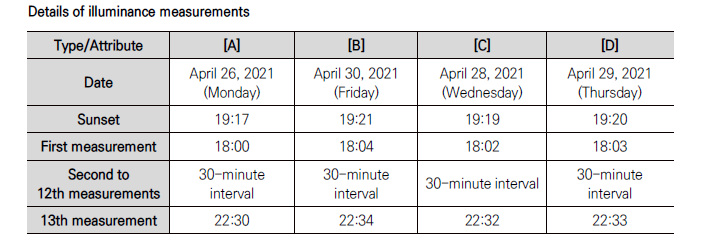

The illuminance measurement over time showed that the illuminance decreased sharply immediately after sunset for all street types. However, the average illuminance level was different at each site. Comparing the minimum measured values of the vertical illuminance, the minimum vertical illuminance levels at Sites A and B after the sixth measurement were similar at around 0.5 lux. The minimum vertical illuminance at Site C was observed to be around 7 lux from the sixth to the eighth measurements, decreasing further by the ninth and tenth measurements. The minimum vertical illuminance of Site D remained at approximately 8 lux after the sixth measurement, with the lowest value observed at the tenth measurement, at 3.65 lux.
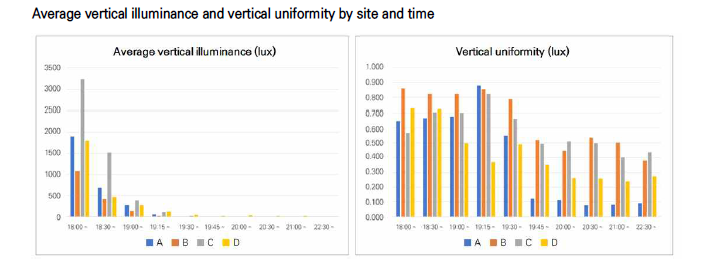
- Recorded VR production
The filming of images for each target site and each time period was carried out for about three to six minutes using a pre-installed camera immediately after the illuminance measurement was finished for each time period at each site. To ensure continuous shooting, a camera was installed at a point where vehicle obstructions could be minimized in the pedestrian passage area, and the height of the lens was set to be 160 cm above the ground. The video to be used for the actual VR survey was chosen from among the total set of recorded videos and underwent post-correction.

- Survey on fear of crime
The survey using Recorded VR was conducted at the VR Lab of Chung-Ang University from May 28, 2021 to June 26, 2021. Participants were asked to complete a preliminary questionnaire after hearing the purpose of the experiment. The preliminary questionnaire consisted of questions related to personal attributes such as age, gender, education level, residential housing type, the number of household members, the frequency of walking on back streets, the average time to return home, and experience with VR as well as questions related to crime victimization experience of the person or acquaintances, and crime vulnerability. After the preliminary survey, the participant put on the HMD device and went through the preparation process. At this time, the survey guide provided the following narration to the participant to induce immersion in the situation.

In order to conduct an immersive experiment during the actual VR experiment, the experimenter provided the following narration each time the VR video was played. “You stopped for a moment on your way home from an outing and are looking around.” The experimenter asked the following questions so that participants could fully experience the situation in the video and report the degree of fear of two types on a Likert-type scale ranging from 1 to 7 points.
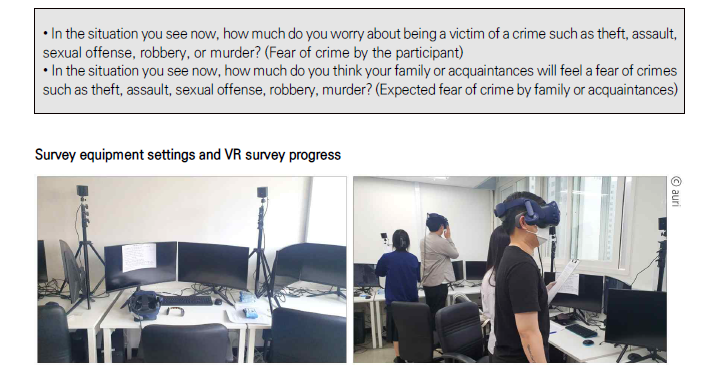
Results of fear of crime according to change of illuminance
When examining the perception of fear of crime according to the change in the illuminance depending on the target area, it was found that a residential area with relatively low light at night led to a greater fear of crime than a commercial area. In addition, fear of crime was found to be greater in areas with high pedestrian traffic than in areas with low pedestrian traffic. Lastly, fear of crime as expressed by the participants and fear of crime predicted in family or acquaintances showed similar tendencies, with the latter being slightly higher.

Regarding gender, females were found to have higher levels of fear of crime than males. This can be explained by vulnerability theory within the fear of crime theory. According to this theory, fear of crime appears differently depending on the individual's levels of physical and social vulnerability. In particular, females responded similarly with regard to their own degree of fear of crime and the expected degree of fear in their family or acquaintances. In contrast, males tended to report relatively high levels of the expected degree of fear of crime by their family or acquaintances.
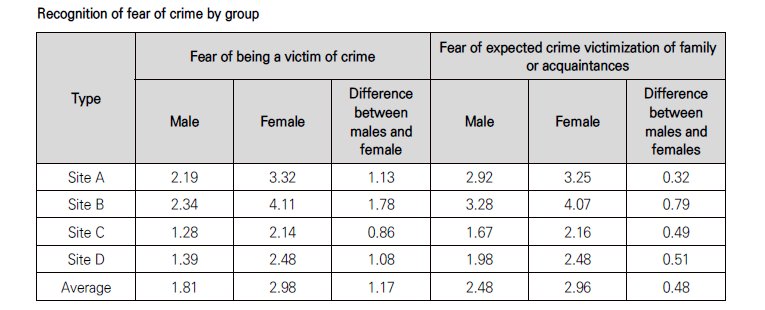
According to the analysis of fear of crime by time, fear of crime increased with time. It was found that the respondents generally felt a low level of fear of crime of less than 3 points (based on a 7-point Likert-type scale) before sunset, while the deviation of the fear level gradually increased after sunset with the mean and median values of fear of crime increasing in tandem.
Next, the relationship between the average vertical illuminance and the average level of the fear of crime at each time point took the form of a logarithmic function with a negative coefficient in which fear of crime rapidly decreased as the level of illuminance was increased, with this trend being the same at all target sites. On the other hand, the uniformity showed a linear relationship with fear of crime, unlike the absolute illuminance value.
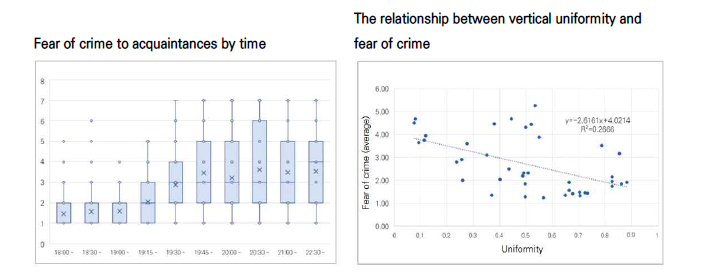
Suggestions Proposal to improve the night illuminance standard
The change in the level of fear of crime by target area with respect to the change in the illuminance showed that the critical point of fear of crime is higher than the current standard illuminance level in residential areas. At the same time, the relationship between illuminance and fear of crime confirmed that fear of crime was alleviated when illuminance is increased. In residential areas, the average fear of crime was higher than the 'normal' level (4 points) in some images (viewpoints) as the illuminance decreased after sunset. However, the specific threshold was slightly different depending on the characteristics of the site. It was found that the average fear of crime was higher than 'normal' (4 points) at 5 lux in a residential area with a high pedestrian volume and less than 1 lux in a residential area with a low pedestrian volume. This suggests that it is necessary to maintain illuminance of at least 5 lux, although the light pollution standard in the residential area should be set to less than 10 lux.1)
On the other hand, in commercial areas, a certain level of illuminance was met until late at night, and the average score for fear of crime was lower than 'normal' (4 points) in all videos. However, due to the restrictions on business hours caused by COVID-19, the illuminance tends to decrease suddenly after the closing hours of commercial facilities, though management of illumination and crime prevention during these times should be considered.
We would like to propose an improvement (proposal) for vertical illuminance by considering the time when fear of crime changes, the current illuminance standard, and the average illuminance and uniformity of the street. In this case, the proposal for vertical illuminance follows the light emission standards in Table 1 below related to Article 6(1) of the Act on the Prevention of Light Pollution by Artificial Lighting.
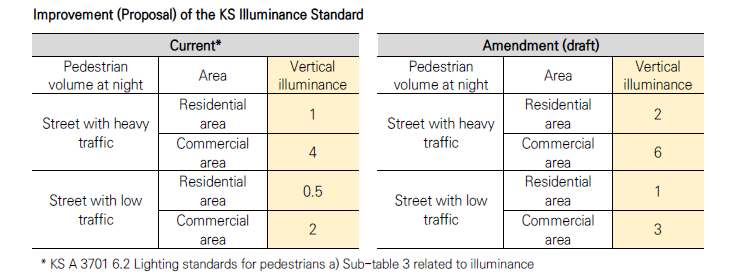
1) Similar results were also found in an experiment examining the appropriateness of the minimum vertical surface illuminance standard to see a person's face and movement at a certain distance. In residential areas, these factors were difficult to identify at 1 to 5 lux when there was high traffic and at 1 to 3 lux when there was low traffic. On the other hand, commercial areas with a certain level of illumination had better overall visibility than residential areas. Details related to the experiment can be found in Chapter 4, Section 3 (Son, Dongpil et al., 2021, pp.108-119) of 'A study on the street lighting illuminance standards for reducing fear of crime.'
- Son, Dongpil, Hyeon, Taehwan & Park, Yuna. (2021). A Study on Road Lighting Standards to Reduce Fear of Crime. Architecture & Urban Research Institute.
- Kim, Myungsun. (2016).A Study on the Realization Plan of Light for Safe Pedestrian Space in Old Residential Area. Doctoral thesis at Chosun University.
- Park, Jeongsook & Jang, Youngho. (2015). A Study on the Nightlight Improvement for Community Crime Prevention. Journal of the Korean Society of Design Culture, 21(2), 261-27.
- Lee, Hyochang, Lee, Jehwa, Kim, Daejin & Ha, Mikyung. (2011). A Study on the Direction of the Lighting Plan for Crime-Free in Street of Commercial District. Seoul Studies, 12(1), 73-89.
- Atkins, S., Husain, S. & Storey, A. (1991). 「The influence of street lighting on crime and fear of crime. London: Home Office.
- Ferraro, K. F. (1995). Fear of Crime: Interpreting Victimization Risk. New York: SUNY Press.
- Hu, X., Qian, Y., Pickett, S. T., & Zhou, W. (2020). Urban mapping needs up-to-date approaches to provide diverse perspectives of current urbanization: A novel attempt to map urban areas with nighttime light data. Landscape and Urban Planning, 195, 103709.
- Kim, D., & Park, S. (2017). Improving community street lighting using CPTED: A case study of three communities in Korea. Sustainable cities and society, 28, 233-241.
- KS A 3701:2014 (2019 confirmed) Street lighting standards. 2019-0591.
- van Osch, T. H. J. (2010). Intelligent Dynamic Road Lighting and Perceived Personal Safety of Pedestrians. Master, Eindhoven University of Technology, Eindhoven. (0640876), 4.
- Wu, S. (2014). Investigating Lighting Quality: Examining the Relationship between Perceived Safety and Pedestrian Lighting Environment. (Doctoral dissertation), Virginia Tech, Blacksburg.
